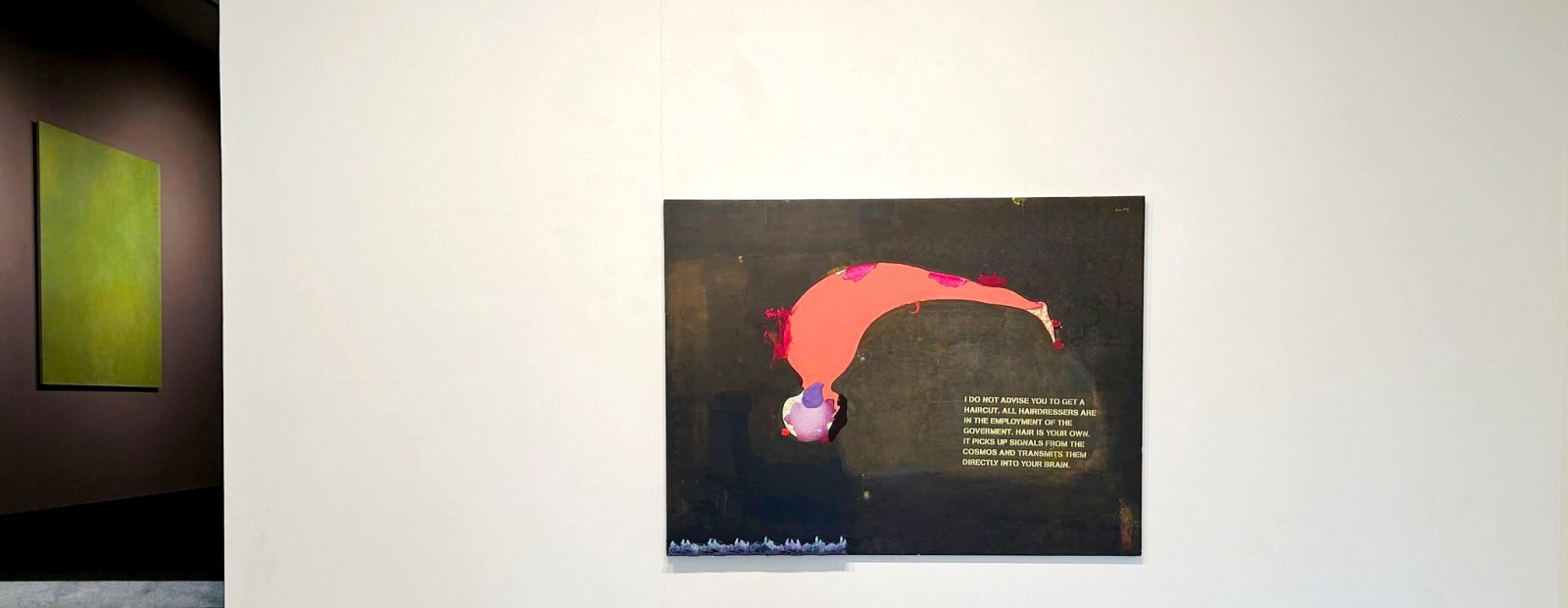In addition to thorough and ambitious exhibitions, such as the study of feminism or the retrospective of the little-known but original artist Rūsiņš Rozīte at the Latvian National Art Museum, the routes of cultural places also feature more chamber-style episodes from the quite recent history of Latvian art. It is difficult to name a field of visual art in which the multi-artist Ilmārs Blumbergs (1943–2016) would not have worked – scenography, graphics, poster, painting, installation, book illustration, photography, cinema… Combining the trends of biomorphic abstraction and surrealism, the art of Ilmārs Blumbergs is quite anthropocentric; at the same time, it exposes the human image to various mutations and schematization – perhaps to emphasize the common aspects of human existence, which today also tend to disappear behind countless identities.
Ambivalent figure
Among the innovative and question-raising personal exhibitions of Ilmārs Blumbergs Household (2002), The drawings are in the box (2003), Prayer for seeing (2004), It’s raining! It’s raining! It’s raining! Buy pictures! Buy pictures! V. Partridge (2010–2011), I won’t die (2013) and other events. Of course, performing arts experts do not need to tell about the high-quality visualizations of Henrik Ibsen’s plays in the 1970s or the opera Aida (1998) and The Magic Flute (2001) performances with profound resonance, which was also followed by the film made together with Viesturas Kairis Riga 800. The Magic Flute as Latvia’s representation at the 49th Venice Art Biennale.
In the gallery Art XO the new exhibition to be viewed Servant, dedicated to the artist’s 80th anniversary, is already a retrospective focused in a certain direction: it highlights the symbolic figure of the Servant, which has migrated through countless works of Ilmar Blumberg. Quoting the author himself: “It came about in the fall of 1993, while working on a group of works entitled Signs. I drew, the content must be given to you. (..) Yes, sometimes it is the figure of the Servant. Sometimes it looks like a worshiper of the Lord – Nature. (..) An ambivalent figure. Sometimes a Supplicant, sometimes a Worshiper” (from the exhibition annotation).
On the one hand, such an aspect may seem too familiar or even clichéd, because almost every connoisseur of Ilmar Blumberg’s art will have a visual idea of the image in question. On the other hand, the news that “most of the exhibition works have never been exhibited” is promising. So you can expect something new in the interpretations of a familiar image, whose chronological range extends from the beginning of the 90s of the XX century to 2009. This boundary is crossed by the sculptural variation of the Servant in cast iron (2021), created by Kārlis Alainis, a peculiar metamorphosis in another form of art.
Hairdressers in Government Service
We would like to add a third version to the mentioned ambivalence of the Servant, which oscillates between humble appearance in front of various masters – this is often attributed to the Latvians as a nation spared by the cataclysm of history – and a more positively evaluated awe when faced with the rationally inexplicable. Namely, a careful observer of the earth and a seeker of something under his feet. This is exactly how, for example, you can read the Servant watching another little servant in his separate bubble – perhaps in the parallel universe (Servant1994).
The figure at work is intriguing I do not recommend cutting hair (1995–2009), which does not bow to anything, but rather hangs upside down above an amorphous cloud with a presumably human profile and text that says that all hairdressers are in government service, but that hair receives signals from space and transmits them directly to the brain . A wide field for reflection on conspiracy theories, the absurdity of which in the recent past has manifested itself with a new dimension in both covid-deniers and Trumpist circles, however, it cannot be denied that these tales have a certain function – to give the sense of a quasi-religious grand plan to random and unrelated events.
On the other hand Service figure in the cycle (2009), collage-like elements are visibly effective, which give symbolic images an affective corporeality. The heads of the figures are supplemented with a butterfly, cotton wool with a blood stain, a piece of strontium or “debris in the brain” – a reference to the artist’s long-term battle with an incurable disease. Ilmar Blumberg’s absolute freedom in terms of the chosen media is well-known and also appreciated this time, combining acrylic, drawing, screen printing, photography, plastic, bronze and various ready-made inlays.
Everything is completely real
Further galleries Art XO Tatjana Krivenkova’s paintings exhibited in the hall can be seen as a prelude to the upcoming exhibition of new works this fall in October, according to the gallery’s calendar. For now, it is possible to focus on 2011-2013. for works created in the year, which are abstractions in the full sense of the word. True, the painter joins the opinion of many artists both in Latvia and elsewhere: “I’m not an abstractionist, I’m a realist, everything I paint is completely real” (Elita Ansone, “In search of a point”, Sharpness: Tatyana Krivenkova: Paintings and drawings, Riga: Māksla XO gallery, 2008, no page). Although it sounds like a justification for the realist tradition, the meaning of this and many similar statements is undoubtedly different – to emphasize changes in the way this real seems possible to express at a certain point in time and space.
Tatiana Krivenkova’s faceted crystalline forms with sharp angles seen in the first decade of the new century, reminiscent of the heritage of Italian Futurism or Russian Reunionism, do not figure here. The close-ups of the canvases in blue, yellow-green and pink tones reveal barely perceptible traces of strokes and the gently uneven undulations they create. The titles of the works can lead to certain associations, allowing you to imagine what is “completely real” in this case. For instance, Gilles and Jim I–II (2011) might encourage you to watch again the film directed by François Truffaut – a new wave icon with a similar title – while Four seasons I. Ilze (2013) and Four seasons III. Armand (2013).
Exhibitions
Ilmar Blumbergs Servant,
Tatyana Krivenkova’s paintings
Gallery Art XO until 26.VIII
2023-08-20 07:01:13
#Episodes #symbols #abstraction #Review #exhibitions #Ilmar #Blumberg #Tatjana #Krivenkova


